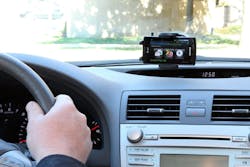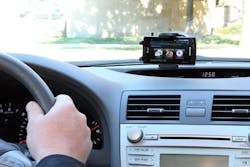Pennies a mile
The Minnesota Department of Transportation (Mn/DOT) recently began research on a demonstration that will involve 500 participants testing technology that could someday be used to collect a mileage-based user fee. The research project, called the Minnesota Road Fee Test, is scheduled to end by December 2012, and results will be made available to the public at www.mndot.gov.
“This research will provide important feedback from motorists about the effectiveness of using technology in a car or truck to gather mileage information,” said Cory Johnson, project manager. “We are researching financing methods today that could be used 10 or 20 years from now when the number of fuel-efficient and hybrid cars increase and no longer produce enough revenue from a gas tax to build and repair roads.”
Minnesota’s highway revenues are derived from three sources: the gas tax, vehicle registration fee or tabs and the motor vehicle sales tax. These funding sources support construction and maintenance of a highway system.
The Minnesota Road Fee Test collects fees for using roads based on predefined prices for a geographic area, type of road and time of day. It does not transmit vehicle location.
If a mileage-based user fee were implemented, motorists would pay a fee based on how many miles they drive, rather than on how much gas a vehicle uses, which is how Minnesota’s gas tax is now designed. The research will help Mn/DOT and public-policy leaders understand the challenges and opportunities in such a system.
Rollout
Volunteers for the project will be recruited in three waves from Wright and Hennepin counties in Minnesota, an area that is a mix of both urban and rural drivers. The first 150 participants have been selected and began using the devices in their vehicles in September 2011. The participants are provided a commercial off-the-shelf Samsung Captivate Android smart phone, which uses customized software that provides participants with navigation, mileage and safety information through a GPS and mobile data connection.
The smart phone includes a 4-in. display with touch screen for easy, safe, hands-free use and can be mounted on the dashboard of any vehicle. No telephone or Internet features are available to drivers during the test. The smart phone uses cellular data networks to transfer information from the device to the secure website that is storing participants’ Minnesota Road Fee Test information.
Phoning it in
The Minnesota Road Fee Test collects fees for using roads based on predefined prices for a geographic area, type of road and time of day. It does not transmit vehicle location. The smart-phone software uses the GPS coordinates of the current location and calculates which fee is associated with that location and criteria set. The software accumulates all of these calculations for the day and then transmits the total miles for each criteria category to the secure website.
The driver also has the ability to save the details of each trip taken that day in the smart phone. This feature allows the driver to dispute the mileage charges if they so choose.
The driver also has the option to transmit their vehicle trips and the associated location data to the website anonymously in order to provide travel-time information to Mn/DOT. The test participant must authorize saving and/or sending the trip information and is the only person who can associate vehicle location and trip information with their account.
As an added value, the smart phone provides participants with real-time traffic alerts that provide information about a road including speeds, construction zones, school safety zones and warnings about dangerous curves in the road.
Three different groups of volunteers will test the devices for six months each. Each participant will be billed monthly and pay the mile-based fee accumulated during the test. The volunteers will receive a nominal stipend to cover the expenses of this test. Each volunteer will be required to participate in an evaluation designed to capture their experiences with the system, the system performance and their concerns about any future system.
Fee options
There are a variety of fee structures that could be used under a mileage-based user-fee system. The challenge is determining which approach is most equitable. Possible fee structures include establishing:
- A flat rate per mile for all drivers, regardless of vehicle type or fuel efficiency;
- A fee structure tied to fuel efficiency; and
- Fee structures that assess fees differently for drivers depending on when or where they drive.
For the purposes of the Minnesota Road Fee Test, the project team established two flat-rate fees. Participants will be charged $0.03 per mile in the Twin Cities metropolitan area during peak travel periods, and $0.01 per mile will apply at all other times. If participants choose to drive without the device at any point during the test, they will be charged a premium “nontechnology” rate equivalent to the higher rate. Miles driven beyond Minnesota will not be included in the study as long as participants use the smart phone.
The technical research is designed to record miles and road use while strictly protecting privacy. The participants’ names and home-contact information, as well as the data that identifies their vehicle, financial account information, travel routes and days and times of trips, are classified as “not public” by the Minnesota Department of Administration to ensure that the research and results are valid.
Driving toward a goal
The Minnesota Road Fee Test aims to demonstrate the capability of a commercially available smart phone to accomplish three primary goals:
- Assess mileage-based user fees;
- Convey safety alerts through in-vehicle signage; and
- Provide a means for vehicles to generate corridor travel times. Because this last goal is a test of feasibility, drivers in the test will not see travel times.
What makes this test unique is that it is using technology as a means for assessing mileage-based user fees. The use of technology allows for a detailed fee structure that can include various factors, such as time-of-day pricing. The project is combining the fee-assessment system with a driver-centered technology (in-vehicle navigation system) and other safety and mobility technologies that are in support of the U.S. DOT’s research in vehicle connectivity. Participant drivers will use real money to pay for road use on the basis of time of day, location, type of roadway and vehicle type.
Mn/DOT has contracted with SAIC Inc. to independently evaluate the user’s experience to help understand whether the technology is an accurate and reliable way to measure mileage-based user fees. In addition, the agency will explore issues about equity through feedback obtained from participants about their perceptions of the fee structure used in the test. An important influence on participants’ perceptions will be their predisposition about technology in general, especially in-vehicle technologies, and attitudes toward state-imposed fees. SAIC will assess baseline attitudes before the system is deployed, and follow up to gather feedback from study participants to assess how drivers’ perceptions change over time as they become more familiar with the technology.
Join the crew
Mn/DOT requested legislative funding to conduct the technology demonstration to evaluate the feasibility of a mileage-based user fee. The 2007 Minnesota Legislature appropriated $5 million from the trunk highway fund for the demonstration.
The Minnesota Road Fee Test is the demonstration project undertaken in part to satisfy that legislative directive. Other state DOTs also are researching new financing methods to supplement or replace a gas tax. The state of Oregon conducted a similar study completed in November 2007, and Iowa, Nevada and Texas are among several states currently researching mileage-based user fees. TM&E

